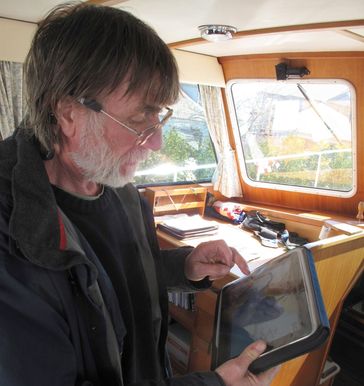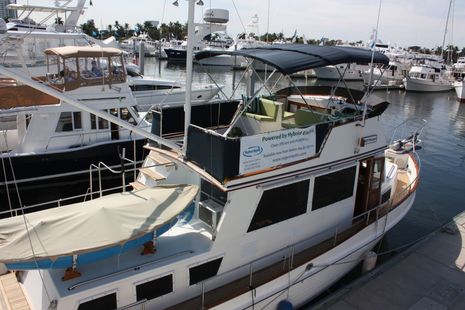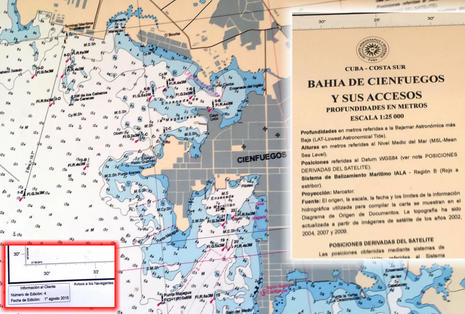
Nigel Calder and I talked non-stop for about six hours on Friday (and probably could have kept going if we were younger men). He visited because he’s working on a new edition of How to Read a Nautical Chart and wanted to check out the latest in electronic charts, particularly the mobile apps. I was happy to help with that, and I also got to ask some questions about Gizmo’s systems and find out what’s up with his marine hybrid project. I’ve always liked Nigel’s chart book; while it’s largely a nice reprint of NOAA’s Chart 1 guide to symbology — no longer published by NOAA, though available for download — it also includes some terrific history of cartography along with analysis of where it’s going electronically. I’ll be particularly interested to see what he discovers when visiting the Chart of the Future project at UNH, which is apparently related to a new vector chart standard (interesting S100 PDF here). I was also pleased to learn that Nigel shares my enthusiasm for improving charts with crowd sourcing and even for 3D charting, and he’s not a guy who’s easily impressed with the latest thing…
and wanted to check out the latest in electronic charts, particularly the mobile apps. I was happy to help with that, and I also got to ask some questions about Gizmo’s systems and find out what’s up with his marine hybrid project. I’ve always liked Nigel’s chart book; while it’s largely a nice reprint of NOAA’s Chart 1 guide to symbology — no longer published by NOAA, though available for download — it also includes some terrific history of cartography along with analysis of where it’s going electronically. I’ll be particularly interested to see what he discovers when visiting the Chart of the Future project at UNH, which is apparently related to a new vector chart standard (interesting S100 PDF here). I was also pleased to learn that Nigel shares my enthusiasm for improving charts with crowd sourcing and even for 3D charting, and he’s not a guy who’s easily impressed with the latest thing…
In fact, it seems that though Calder would like to see fuel-efficient, environment-friendly hybrid marine power work as much as anyone — and has spent more time than most studying the concept — he’s still not convinced! Since
I last wrote about the HyMar research project, it’s gotten
a good web site where you can see the plentitude of partners and goals involved. But Nigel, who serves as chief technical officer, tells me that he is still struggling with accurate measuring tools so he can truly compare the efficiencies of diesel and electric motors, propellers, and batteries…and hence their various hybrid combinations. He’s skeptical about published performance specs and deep into details of torque sensing, fuel flow measurement, specific diesel fuel energy content, etc. etc.
Frankly I don’t understand a lot of the issues, but Nigel did help me see the hybrid concept in terms of my own boat and what only seems like my “efficient” habit of running her at displacement speeds. I do get much better miles per gallon at 8 knots than I do at 16, but that’s because the superior fuel efficiency of my Volvo Penta at higher RPMs is masked by
Gizmo’s much greater hull resistance at semi-planing speeds. One goal of hybrid is to match an engine’s fuel efficiency curve with a boat’s hull resistance curve. In an ideal world, I’d usually be running an engine hard for short periods to store house and easy propulsion energy, but would still have some serious horsepower to apply when needed.
One of the hybrid issues that Nigel has written about in
Professional Boatbuilder (
search back issue index here) is the need for top end power in rough seas and high winds, and apparently his testing in Sweden is proving the truth of that concept. The last knot of displacement boat speed, sometimes left out of early hybrid attempts, takes a heck of lot more power, and it’s the same power needed to make way when things get nasty. Which accounts in part for the hybrid boats that eventually went back to conventional propulsion systems.
At any rate, I’m going to keep my eye on
that HyMar site, hoping Nigel’s pursuit of truth hits pay dirt, but it’s also nice to see some new players in marine hybrid. For instance there’s
Hybrid Propulsion in Portsmouth, NH, which has created the system that’s diagrammed below and that may be cruising where I can see it this summer…
There’s also
ReGen Nautic USA down in Ft. Lauderdale, which showed off its hybrid Grand Banks
Watt Power! (below) during the Miami Boat Show (though I missed it) and also has some
good diagrams illustrating the difference between serial and parallel hybrid systems. And I was impressed with the simplicity of
Beta Marine’s all-in-one 25-60 hp hybrid systems when I saw them on display at the Newport Show. Finally, the huge German firm ZF is purportedly providing hybrid power and drive systems for a fleet of charter canal boats, though I can only fine a
this hardware catalog PDF. Maybe readers know more about this project, or others, or have an opinion on the future of hybrid marine propulsion?
and wanted to check out the latest in electronic charts, particularly the mobile apps. I was happy to help with that, and I also got to ask some questions about Gizmo’s systems and find out what’s up with his marine hybrid project. I’ve always liked Nigel’s chart book; while it’s largely a nice reprint of NOAA’s Chart 1 guide to symbology — no longer published by NOAA, though available for download — it also includes some terrific history of cartography along with analysis of where it’s going electronically. I’ll be particularly interested to see what he discovers when visiting the Chart of the Future project at UNH, which is apparently related to a new vector chart standard (interesting S100 PDF here). I was also pleased to learn that Nigel shares my enthusiasm for improving charts with crowd sourcing and even for 3D charting, and he’s not a guy who’s easily impressed with the latest thing…
















The most successful (parallel) hybrid boats in Europe are these:
http://www.greenlinehybrid.com/index.php
http://www.seawaygroup.eu/news/?m0=7&m1=0&id=43
Stress lies on environmental friendly (=no noise in harbors, channels, lakes). I doubt about effiency. And for range you have Diesel here.
The technical base are engines from VW Marine, electrical systems are from ISKRA and Victron.
The leisure group TUI is building a fleet of charter boats for inland waterways based on Greenline’s technical concept:
http://www.leboat.co.uk/flotte/15041
If Nigel is interested in a partner for discussing measurement and datarecording concepts he might contact 2d-datarecording.com
Their main field are motorsports, but he will find a lot of expertise from other areas and very open minded people.
Thanks for the mention of Hybrid Propulsion. You also bring up a couple excellent points. Early hybrid boat projects often undersized the motors because of the difficulties of dealing with the high DC voltages needed for larger motors, and the availability of high power permanent magnet motors. They also made a lot of performance claims for electric motors that just didn’t make sense. There’s no free lunch. If your boat needs 100 shaft horsepower to maintain hull speed then that’s what it needs. If it needs 500 horsepower to plane, then you are going to need about seven tons of lead batteries to plane for an hour (or a ton and half of Li-on).
As you stated, the approach that makes for best fuel economy is to operate at displacement speeds, run under battery at low speed or while motor-sailing, and run diesel-electric with occasional battery assist at high speed.
I started Hybrid Propulsion when I couldn’t find a supplier for hybrid power for my own 57′ retirement sloop. Over the past two years, we’ve focused on the safety systems needed for dealing with 500 volt DC in a marine environment, battery balancing of high voltage battery banks, and economical electronics for converting power as needed. A unique feature of our approach is that we maintain variable voltage variable frequency power (V3F) throughout the system, only converting to and from DC at the batteries.
We’re currently engineering the propulsion for a 70-ton 110′ schooner, the America 2.0, a high-tech rebuild of the original Americas Cup contender. I believe that this may be one of the largest hybrid sail projects undertaken and we’re excited to be part of the project.
– Bill Southworth, CEO, Hybrid Propulsion LLC
Thank you, Bill and Anonymous!
Another noteworthy hybrid build is the first Tag 60 catamaran, named Tang, which includes E Motion’s largest system to date: http://goo.gl/uJVuq
Tang is sailing now, as you can read in the Tag site newsletters: http://www.tagyachts.com/news.php
She seems like a pretty remarkable boat, but I wonder if a pair of 18 kW electric motors will be able to keep her off a lee shore in the same conditions a pair of diesels might. I see that a vaguely similar Gunboat 66 is equipped with Volvo Penta D2-55 engines.
Ben, do you know if Nigel maintains any kind of blog or website? Every time I pick up Boatowners Mechanical and Electrical Handbook, I’m struck with another thought or question… Thanks,
It seems to me that anyone who obsesses over each tenth of a GPH at full cruise speed that a hybrid drivetrain burns to prove how “inefficient” these systems are, is asking the wrong question.
The true value of a hybrid system is shown when you use a whole systems approach to calculate the total watt/hours per month used by the entire boat to include underway propeller shaft loads, underway electrical loads (lights, Nav, Comm, Autopilot, winches, etc.), and at anchor house loads, which can be substantial.
Then divide that by the weight and cost required to provide ALL those watt/hours by your current hodgepodge of propulsion/generation systems, VS a dedicated high output generator propulsion/charging system.
Costs include:
Diesel gallons/month
Main Engine and or secondary Generator hrs/month required to replace all loads
Main engine maintenance reserve – $$/hr for rebuild/replacement/parts/oil changes
Generator maintenance reserve
Battery charge efficiency: – correct me if I’m wrong
LifeP04 – 98%
AGM – 90%
Wet Cell – 80%
(many people ignore this hidden cost)
Battery Acceptance Rate – extra engine hrs/month
It has been said that even the most intrepid world cruisers spend more than 90% of their time at anchor. With the proliferation of creature comforts coming standard (or required by the Admiral) onboard, I would venture to say that, especially for sailboats, the house loads equal or greatly exceed the propulsion loads and the total system that can provide these most efficiently, quickly and quietly will be the most economical in the long run.
Being able to recharge you entire battery bank in 30 minutes – priceless.
For powerboaters, the addition of a big enough battery bank that could be recharged at the slip and then be used for most of the day before the engine needed to be started to extend your range can result in substantial savings.
Many years ago there was a company, OSSA POWERLITE® http://www.ossapowerlite.com/index.htm, which was starting down the Diesel-Electric road. They were owned by Glacier Bay who had done much with efficient DC power for home, marine and over the road truckers. Additionally they had made many advancements with AC, refrigeration and insulation technologies. They seem to have dropped out of the game but still have a lot of information which might benefit this fledgling industry. One huge advantage they pointed out was the narrow efficient power range of diesel motors, whereas an electric motor is just as adept at 1 RPM as it is at 5000 RPM. This frees designers to put any size/pitch prop on the vessel without regards to stalling the engine or the max RPM. Here is the only link at this site which still works http://www.ossapowerlite.com/tech_library/fuel_efficiency/fuel_efficiency.htm but this gives an in-depth explanation on why Diesel-Electric is an attractive alternative to conventional diesel propulsion.
Grant, sorry to say that Nigel is not much for blogging, and claims he can’t operate a modern phone, but then again he does seem to be focused. The hymar.org site, along with Professional Boatbuilder, is where you’ll find some of his work.
John, I agree completely that power should be viewed as a whole vessel deal, and think that’s what you’ll see at hymar.org.
David, I drank a bit of the Ossapowerlite koolaid myself, as referenced in my earlier entry about HyMar. Too bad it didn’t seem to work properly, or sell, or something.
Good point on the house loads. My wife and I have spent a lot of time as winter live-aboards in such places as Nova Scotia, Maine and Boston. The diesel heater stank up the whole boat and much of the marina and we had to haul about 20 or 30 gallons of diesel per week in Jerry jugs since we couldn’t get to a diesel fill in January or February. With our hybrid system, the diesel hot water heater has been replaced by a 10 lb 20kW electric heater. We can run off shore power, batteries at night, or generator, or any combination. On a hot summer day at a stuffy urban dock, we can run the air conditioning full blast all day and just run the generator for about an hour in the morning and an hour in the afternoon. We also save significantly on water waste by using an instant hot water heat for showers rather than maintaining a hot water tank.
I know this plush life style of hot water showers, heat and air conditioning is anathema to purists but it is real life and we do like our comforts.
Unfortunately there is no fee lunch in marine propulsion. A system that uses an engine running at its most efficient power point to charge batteries which then power an electric motor to turn the propeller, may sound more efficient. But this will probably be offset by power loss in the motor and generator. If anyone can identify such as system that beats a gear transmission, Nigel can do it, but like him I am skeptical. Yes, the batteries can be charged from shore power instead of an on-board generator, but this simply replaces one fuel (diesel) with another (purchased electricity).
Chevy Volt uses this system, but hybred vehicles have one thing that boats can never have, which is regenerative braking. There is no method of power transmission that is more efficient than a simple gear transmission. Some times a vehicle that requires very high torque at very low revolutions will work better with something other than gears (eg: diesel/electric railway locomotive, or hydrostatic drives on construction machinery), but this certainly doesn’t describe marine systems.
To improve efficiency, I think we need to work on hull design. My boat, a 36 ft trawler with a 220hp Cummins diesel, is much too wide for its length (the Admiral likes it that way), and the engine is much too big, most of the time. But I still think that the builder made a wise choice for reasons that are not relevant here.
A displacement hull that is long and narrow with a small engine (eg: Steve Dashew’s boats) will always be more efficient than a hull like mine with any kind of diesel/electric/battery drive.
Nigel is one of my heroes,Before I started wiring my own boat I bought a copy of his Boat owners mechanical and electrical manual.It’s still right there on my bookshelf in my berth.Not something I loan out either!
This is only slightly off topic, but the most used book I own is my worn copy of Nigel’s “Boatowners Mechanical and Electrical Manual”. I alway carry the his “Bible” with me in the truck, and I think all boat owners should have a copy onboard. It is jammed packed with info covering wiring to steering, and I refer to it regularly.
Rick R is right that hybrid is all about tradeoffs. If you only run at optimal diesel performance (often about 2200 rpm) then it’s hard to beat diesel. Also, for energy density it’s hard to beat diesel fuel. Electric drive (forgetting the battery part) loses a bit of efficiency in the conversion to electric by an alternator and then back to mechanical by the motor. Efficiencies of diesel electric propulsion in large vessels come from being able to stage diesel generators and to mix and match the diesels with twin props.
The other big advantage to diesel electric is that the same generator or generators that power the vessel, usually for a small fraction of the time, can be used for house power.
Batteries have opposite tradeoffs from generators. Batteries are most efficient when drained at low power. They also have much worse energy density than petroleum so capacity is an issue. On the other hand, electric power stored from shore is cheaper than diesel.
If you think about it a bit, the same tradeoffs hold for a boat as a Chevy Volt. It’s best to use the batteries for low speed, short distance operation and for providing house power at the low load levels of much of the day and all night. The generators provide for peak loads and for replenishing the batteries at sea. You take advantage of the increased energy density of the diesel fuel on long trips.
I don’t understand Rick’s gearbox comments. I view gearboxes as a necessary evil that introduce losses in order to match inadequate torque with loads. We use these with electric propulsion too, when a motor likes to run at several times the desired prop speed.
As for regeneration, a sailboat is actually a better platform than an automobile for regenerating power. While under sail, the prop can generate a significant amount of power with a couple percent loss in boat speed. The physics is complicated and I don’t pretend to understand all the equations and simulations. But here’s my understanding. As you approach hull speed under sail, increases in wind speed increase boat speed by an ever smaller amount. As you approach this, prop drag doesn’t slow down the boat noticeably. The simulations we’ve seen say that the theoretical limit regenerated is about 25 to 30% of the power moving the boat. If your boat is not too significantly overpowered by sail, you probably can get back about 20kW from a 100kW propulsion motor. That’s not inconsiderable as a house power provider or for recharging the batteries for no wind later.
Regeneration under sail is probably only really important for the major voyager. If much of your time is spent under sail, you can most likely circumnavigate with all your creature comforts with no diesel used.
– Bill Southworth, CEO, Hybrid Propulsion LLC
While Hybrid power for boats is all fine and dandy the truth is, for recreational boats at least, is that they do very few hours each year and burn relatively few gallons of fuel albeit gas or diesel. Also most marine diesels wear away from rust and lack of use they do not wear out from work, in fact it is positively bad for an engine not to reach proper operating tempratures. If you run on electrical power thus reduce the amount of time operating your diesel which may only amount for many boaters of 50 to 100 hours per year the wearing issues are compounded, not to mention the added expense and complication that hybrid power brings. I think that full electrical power for day sailers and other small boats that spend mauch of their time tied to the dock and thus have a ready supply of battery charging current via shore power is a splendid idea. But to my mind at least I have yet to be convinced that hybrid power is good thing for recreational vessels. If it’s just a matter of saving fossil fuels and making boats cheaper then the payback will be better by using a boat with a smaller engine combined with good efficient hull design.
Mark – If you have one genset providing both house power and propulsion, you actually exercise your single diesel more often and you always run it peak efficiency. If, on the other hand, you only use an alternator on a PTO to charge your house batteries, then it would be simpler, but I’d argue that one diesel is less maintenance than two. The electric motors require negligible maintenance. Also, I’ve found that having enough power to have electric appliances has cut down on maintenance. My old diesel heater that needed a rebuild every September and February is a good example of a system that I don’t miss.